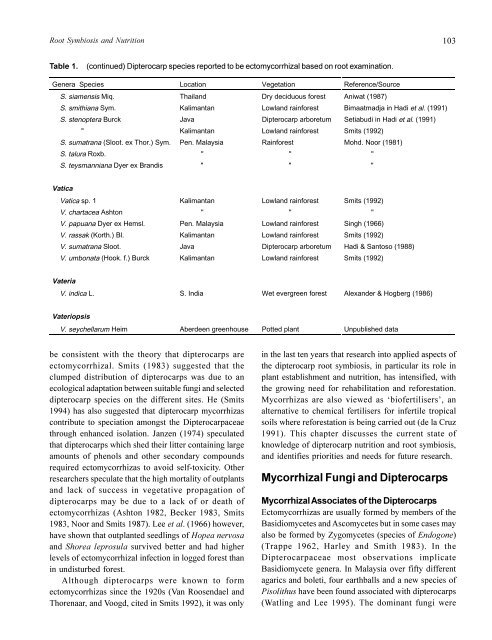A review of dipterocarps - Center for International Forestry Research
A review of dipterocarps - Center for International Forestry Research
A review of dipterocarps - Center for International Forestry Research
You also want an ePaper? Increase the reach of your titles
YUMPU automatically turns print PDFs into web optimized ePapers that Google loves.
Root Symbiosis and Nutrition<br />
Table 1. (continued) Dipterocarp species reported to be ectomycorrhizal based on root examination.<br />
Genera Species Location Vegetation Reference/Source<br />
S. siamensis Miq. Thailand Dry deciduous <strong>for</strong>est Aniwat (1987)<br />
S. smithiana Sym. Kalimantan Lowland rain<strong>for</strong>est Bimaatmadja in Hadi et al. (1991)<br />
S. stenoptera Burck Java Dipterocarp arboretum Setiabudi in Hadi et al. (1991)<br />
" Kalimantan Lowland rain<strong>for</strong>est Smits (1992)<br />
S. sumatrana (Sloot. ex Thor.) Sym. Pen. Malaysia Rain<strong>for</strong>est Mohd. Noor (1981)<br />
S. talura Roxb. " " "<br />
S. teysmanniana Dyer ex Brandis " " "<br />
Vatica<br />
Vatica sp. 1 Kalimantan Lowland rain<strong>for</strong>est Smits (1992)<br />
V. chartacea Ashton " " "<br />
V. papuana Dyer ex Hemsl. Pen. Malaysia Lowland rain<strong>for</strong>est Singh (1966)<br />
V. rassak (Korth.) Bl. Kalimantan Lowland rain<strong>for</strong>est Smits (1992)<br />
V. sumatrana Sloot. Java Dipterocarp arboretum Hadi & Santoso (1988)<br />
V. umbonata (Hook. f.) Burck Kalimantan Lowland rain<strong>for</strong>est Smits (1992)<br />
Vateria<br />
V. indica L. S. India Wet evergreen <strong>for</strong>est Alexander & Hogberg (1986)<br />
Vateriopsis<br />
V. seychellarum Heim Aberdeen greenhouse Potted plant Unpublished data<br />
be consistent with the theory that <strong>dipterocarps</strong> are<br />
ectomycorrhizal. Smits (1983) suggested that the<br />
clumped distribution <strong>of</strong> <strong>dipterocarps</strong> was due to an<br />
ecological adaptation between suitable fungi and selected<br />
dipterocarp species on the different sites. He (Smits<br />
1994) has also suggested that dipterocarp mycorrhizas<br />
contribute to speciation amongst the Dipterocarpaceae<br />
through enhanced isolation. Janzen (1974) speculated<br />
that <strong>dipterocarps</strong> which shed their litter containing large<br />
amounts <strong>of</strong> phenols and other secondary compounds<br />
required ectomycorrhizas to avoid self-toxicity. Other<br />
researchers speculate that the high mortality <strong>of</strong> outplants<br />
and lack <strong>of</strong> success in vegetative propagation <strong>of</strong><br />
<strong>dipterocarps</strong> may be due to a lack <strong>of</strong> or death <strong>of</strong><br />
ectomycorrhizas (Ashton 1982, Becker 1983, Smits<br />
1983, Noor and Smits 1987). Lee et al. (1966) however,<br />
have shown that outplanted seedlings <strong>of</strong> Hopea nervosa<br />
and Shorea leprosula survived better and had higher<br />
levels <strong>of</strong> ectomycorrhizal infection in logged <strong>for</strong>est than<br />
in undisturbed <strong>for</strong>est.<br />
Although <strong>dipterocarps</strong> were known to <strong>for</strong>m<br />
ectomycorrhizas since the 1920s (Van Roosendael and<br />
Thorenaar, and Voogd, cited in Smits 1992), it was only<br />
103<br />
in the last ten years that research into applied aspects <strong>of</strong><br />
the dipterocarp root symbiosis, in particular its role in<br />
plant establishment and nutrition, has intensified, with<br />
the growing need <strong>for</strong> rehabilitation and re<strong>for</strong>estation.<br />
Mycorrhizas are also viewed as ‘bi<strong>of</strong>ertilisers’, an<br />
alternative to chemical fertilisers <strong>for</strong> infertile tropical<br />
soils where re<strong>for</strong>estation is being carried out (de la Cruz<br />
1991). This chapter discusses the current state <strong>of</strong><br />
knowledge <strong>of</strong> dipterocarp nutrition and root symbiosis,<br />
and identifies priorities and needs <strong>for</strong> future research.<br />
Mycorrhizal Fungi and Dipterocarps<br />
Mycorrhizal Associates <strong>of</strong> the Dipterocarps<br />
Ectomycorrhizas are usually <strong>for</strong>med by members <strong>of</strong> the<br />
Basidiomycetes and Ascomycetes but in some cases may<br />
also be <strong>for</strong>med by Zygomycetes (species <strong>of</strong> Endogone)<br />
(Trappe 1962, Harley and Smith 1983). In the<br />
Dipterocarpaceae most observations implicate<br />
Basidiomycete genera. In Malaysia over fifty different<br />
agarics and boleti, four earthballs and a new species <strong>of</strong><br />
Pisolithus have been found associated with <strong>dipterocarps</strong><br />
(Watling and Lee 1995). The dominant fungi were

















